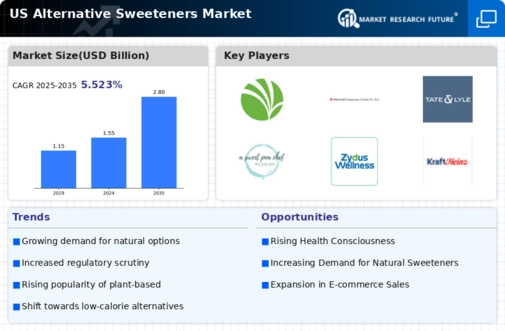Health Consciousness Among Consumers
The increasing health consciousness among consumers appears to be a pivotal driver for the alternative sweeteners market. As individuals become more aware of the health implications associated with excessive sugar consumption, they are actively seeking healthier alternatives. This trend is reflected in the market data, which indicates that the demand for low-calorie and natural sweeteners has surged, with a projected growth rate of approximately 8% annually. Consumers are gravitating towards products that offer sweetness without the associated calories, thereby propelling the alternative sweeteners market forward. Furthermore, the rise in obesity and diabetes rates in the US has led to a greater emphasis on dietary choices, further influencing consumer preferences towards healthier sweetening options. This shift in consumer behavior is likely to continue shaping the landscape of the alternative sweeteners market in the coming years.
Rising Demand for Plant-Based Products
The rising demand for plant-based products is emerging as a significant driver for the alternative sweeteners market. As consumers increasingly adopt plant-based diets for health, environmental, and ethical reasons, the need for natural sweeteners derived from plants is becoming more pronounced. This trend is supported by market data indicating that the plant-based food sector is expected to grow at a CAGR of 10% through 2027. Consequently, alternative sweeteners that are plant-derived, such as stevia and monk fruit, are gaining traction among consumers seeking healthier and more sustainable options. This shift not only reflects changing dietary preferences but also aligns with the broader movement towards sustainability in food production. the alternative sweeteners market will benefit from this growing inclination towards plant-based ingredients..
Expansion of Food and Beverage Industry
The expansion of the food and beverage industry in the US is significantly impacting the alternative sweeteners market. As new products are developed and introduced, manufacturers are increasingly incorporating alternative sweeteners to cater to the evolving preferences of health-conscious consumers. the market for low-sugar and sugar-free products will reach $30 billion by 2026., indicating a robust demand for alternative sweeteners. This growth is driven by the rising popularity of functional foods and beverages that offer health benefits, such as weight management and improved metabolic health. Additionally, the trend towards clean label products has prompted manufacturers to seek natural sweetening solutions, further bolstering the alternative sweeteners market. The continuous innovation in product formulations and the introduction of new flavors are likely to sustain this growth trajectory.
Increased Regulatory Support for Healthier Options
Increased regulatory support for healthier food options is emerging as a key driver for the alternative sweeteners market. Government initiatives aimed at reducing sugar consumption and promoting healthier dietary choices are influencing manufacturers to reformulate their products. Policies encouraging the use of low-calorie sweeteners in food and beverages are likely to create a more favorable environment for the alternative sweeteners market. For example, the FDA has been actively involved in evaluating and approving new sweetening agents, which may lead to greater consumer acceptance and usage. This regulatory landscape is expected to foster innovation and investment in the development of alternative sweeteners, ultimately benefiting the market. As consumers become more aware of these healthier options, the demand for alternative sweeteners is likely to rise.
Technological Advancements in Sweetener Production
Technological advancements in sweetener production are playing a crucial role in shaping the alternative sweeteners market. Innovations in extraction and processing techniques have led to the development of high-quality sweeteners that retain desirable taste profiles while minimizing caloric content. For instance, advancements in fermentation technology have enabled the production of sweeteners from natural sources with enhanced efficiency. This has resulted in a wider variety of alternative sweeteners available to consumers, catering to diverse taste preferences. Moreover, the ability to produce sweeteners at a lower cost may enhance market accessibility, potentially increasing consumption rates. As technology continues to evolve, it is likely that the alternative sweeteners market will see further diversification and improvement in product offerings.



















Leave a Comment